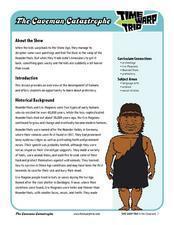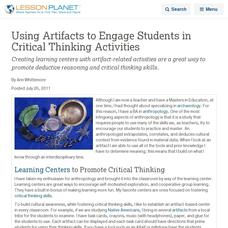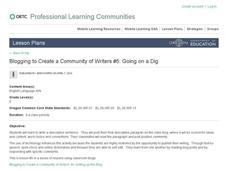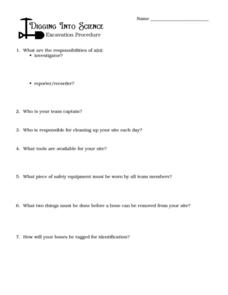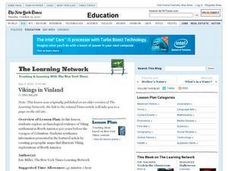Curated OER
The Mesoamerican Mystique
Students gain a better understanding of the cultural diversity in the northern region of Central America. They engage in a instructional activity which focuses on research, archaeology, historical videos, and travel highlights.
Curated OER
Hands-on History of Pottery
Students make pottery in the same evolutionary order as archeology indicates. They begin with simple pinch pots and then move to plain coil pots, manipulative decoration, and surface decoration. For each type of pot they discuss the...
Curated OER
Pottery-making Methods
Students become experimental archaeologists using three methods of pottery making before the invention of the pottery wheel.
Curated OER
Stone Tool Scavenger Hunt
Students use the internet to research the various types of stone tools used by natives. Using this information, they create a chart describing each tool and its usage. In groups, they share their charts with others and answer...
Curated OER
Archaeology 2500: Texano Weapons
Students listen to oral story describing mystery artifact, work in groups to write descriptive report of artifact, and creatively form hypothesis based purely on misinterpretation. Students then explore and discuss difficulty of...
Time Warp Trio
The Caveman Catastrophe
Young archaeologists study the development of human history, and work in groups to create a timeline that traces the development of humans. Additionally, the groups utilize a very clever graphic organizer embedded in the plan in order to...
Curated OER
Using Artifacts to Engage Students in Critical Thinking Activities
Creating learning centers with artifact-related activities are a great way to promote deductive reasoning and critical thinking skills.
Curated OER
Blogging To Create A Community of Writers # 5 of 7
Here is lesson 5 from a 7 lesson unit on using blogging to create a community of writers. The aim of this lesson is to get students writing about what Archaeologists do and how they use material data to study the past. They compose a...
Curated OER
How to "Read" an Artifact
Students discuss the types of information they can get from artifacts. In groups, they practice "reading" artifacts and determining their usage. They use inferences to test against official information about certain pieces. They also...
Curated OER
Chalkboard Challenge: The Beginning of Human Society
After studying Ancient Civilizations, learners could use this jeopardy-like game as a review. Having questions relating to the Neolithic, Paleolithic Era, and more, this presentation would be a great whole class or center activity.
Curated OER
Clay Wipe Away: Ceramics
Discuss Pre-Colombian South American art with your class, then get out the clay and create some. Pupils practice using the wipe-away technique to create a ceramic tile similar to those made by the Maya. Great web links and a...
Curated OER
Invaders and Settlers: The Vikings
Introduce your young historians to the amazing Vikings! This presentation provides information on the culture, travels, rule, religion, and tools used by the Vikings. After each 3-5 slide section are slides containing compression...
Curated OER
Dig This
Fifth graders explore the work of paleontologists and the life of dinosaurs and create a sculpture of the bones of a Stegosaurus. The sculpture was then buried and used by other classes for a dig.
Curated OER
Let's Go To The Movies
Students explore technology used in making movies. In this movie making lesson, students investigate how technology has improved in the entertainment industry. Students discover how simple tools are combined together to make complex...
Curated OER
Hominid Diet
Students listen to an interview with Lucinda Backwell regarding fossil evidence that early hominids included termites in their diets. They participate in a discussion to investigate the significance of these findings.
Curated OER
Ancient Man in Asia
Seventh graders analyze and synthesize information about major historical developments by interpreting data, evaluation sources of information, identifying and comparing experiences and perspectives from multiple cultural perspectives.
Curated OER
Name That Point!
Students compare projectile point attributes, identify and classify points, and match projectile points to a chronology.
Curated OER
Mapping and Excavating a Jello Mold
Fifth graders, in groups, map the three layers of different colored jello layers in molds and note the placement of fruit in them. On the grid paper they draw each grape, raisin, or other object and carefully remove each layer. After...
Curated OER
Digging Into Science: Excavation Procedure
In this excavation procedure instructional activity, learners determine the roles of group members for an excavation of a sample box containing buried bones. They complete 9 short answer questions before beginning the excavation.
Curated OER
Detectives of the Past: Dr. Archaeology Travels Back in Time
Students watch a video and complete a webquest to gain a better understanding of the historical significance of the first known civilization, Mesopotamia.
Curated OER
Stonehenge: Solving Ancient Mysteries
Students explore archeologists and anthropologists and the tools and methods they use to gather and interpret scientific evidence. They research current archaeological excavations and contact the scientists working at these digs.
Curated OER
Vikings in Vinland
Students examine the role of archaeology in gaining information about past civilizations. After reading an article, they discover evidence of the Viking settlement of North America. They summarize the information in the article by...
Curated OER
Welcome to The Immortal Emperor
Students watch a flim while collecting information about China in the third Century BC and about its First Emperor, Qin Shihuangdi. They examine the tools use by archeologist and investigate the human quest for immortality in this series...
Curated OER
Cave Art Drawing
Young scholars design an environment that resembles a prehistoric cave. They use ancient rock art as inspiration for their own artistic expression. They demonstrate their understanding of the vocabulary, tools, and techniques used in...





